Beijing pictures
I went to Beijing with Pepperdine students Mike and Jenna, and Ohio University students Sean and Yee. Sean and Yee left a day earlier. Other Pepperdine students went a day earlier too, but we never met up with them.Beijing, once a bastion of communism, now a bastion of marketing. On the flight there (China Air), we got ads on our seatbacks.

The top part is "Citic Bank", whatever that's supposed to be. The blue sticker would have looked like random vandalism if it weren't placed in exactly the same spot on every single seatback on the plane. I forgot what it was advertising, and my camera's not good enough for me to figure it out from this picture.
And this is before we land! On the ground, we see ads, mostly on behalf of the Chinese government.

Beijing 2008, it says. I don't know if olympics normally get hyped two years ahead of schedule, with a countdown and everything. But you can find countdowns everywhere. This one is in front of a museum on Tiananmen Square.
Here are soldiers marching in on Tiananmen Square, just for a changing of the guard.

Everywhere Beijing is officially welcoming people. They had a lot of things set up for the Africa-China development summit, which actually started after we left.

Apparently China has been investing like crazy in Africa, mostly because Africa has raw resources (metal, oil, etc.) that China desperately needs during this growth spurt, and the West hasn't been doing it. Only now there's some concern among the Africans that the Chinese are underpaying people and in general not being nice. There's probably some culture clash going on, in terms of what both sides are expecting. But in general, there's a lot of hope on both sides for mutual benefit.
I'll try not to give you the pictures you can easily find on the web. Here's the famous Tiananmen gate with Mao's picture, but you get to see people bustling through. And a police car trying to make it through, too. Sometimes, in Tiananmen, the police don't always get what they want immediately.
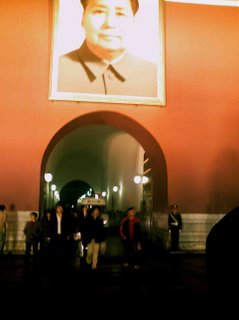
We did make it out to the Great Wall, not at the usual stop in Badaling, but a more secluded area in Huanghua. Here's the countryside on the way there.
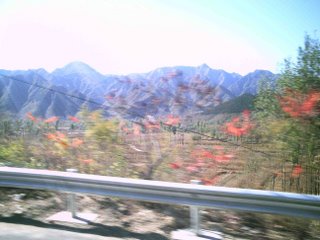
We took a bus out to Huairou, and a taxi from there to Huanghua. We paid 100 yuan for the trip there, and asked the driver to wait. As it turned out, we didn't end up at the place where the taxi was, and I would feel worse about it if it weren't for the fact that there was a bus that took us all back to Huairou for 4.5 yuan each, indicating that the driver knew just how much she was overcharging us, and knew that we would find cheaper transportation back. She probably took off after a bit of waiting.
This part of the wall is not restored, and the road in fact cuts right through it. The entrance is along a dam on a reservoir.

Officially, the government says not to climb the wall here. They even put up a sign. But locals here set up shop, charging tourists 2 yuan apiece to enter the site. Further along the wall, some locals set up a makeshift gate made of twigs, and charged us 20 yuan to go through. Communism had no chance with these people.
The wall is quite a climb in places. Sometimes, stairs. Sometimes a very steep ramp. It's in pretty good condition for something that is not restored, but not all the steps are very even.
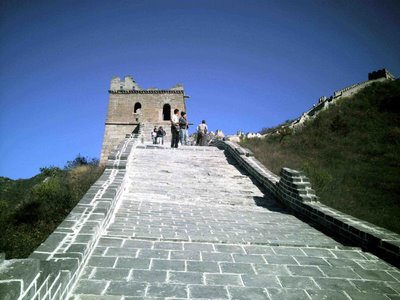
The wall is long. In Chinese it's not called the "Great Wall"--it's called the "Long Wall" (長城)and indeed, though it's wide enough and tall enough to be an impressive feat, it's true breathtaking quality is its length, going on and on, dragon-like, across the mountains.
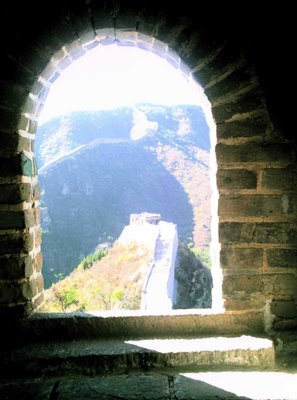
This is from one of the parapets.
But it's easy to see why the Great Wall never worked--tall as it was, the height was still nothing compared to the mountains nearby. For people willing to scale the mountains, what would the wall do? And the Huns, the Mongols, the Manchus, were all nomadic people, and for nomads, they can always choose their invasion point to be wherever the wall is weakest.
I hear we're thinking about putting a wall across our border with Mexico. I think China will laugh, saying, "we already tried that."
Here's a spot where the wall overlooks a village:
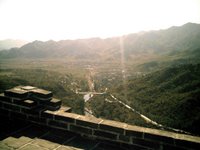
Eventually, the wall crumbles into rubble. Some people went down this treacherous climb. I didn't. But we all ended up descending the wall and going down a trail to the village. On the way, a peasant with lots of dogs charged us 3 yuan apiece for going through her property. The guidebook's directions were completely useless--there was so much development here (a new road, a very nice house under construction) that these guidebooks go out of date very quickly. We randomly wander in the direction of the highway we came in and eventually made it there.
We found a restaurant (we had skipped lunch so we were hungry and thirsty) advertising the fact that it was featured in the Lonely Planet guidebook.

The owner was a bubbly older woman, who loves to go on about how she's in the Lonely Planet guidebook. She's very friendly, and happily takes our order. She also sells souvenirs. We're so glad to see that a restaurant with water exists, that we happily buy lots of souvenirs. Here's the restaurant/inn:

We got to hang out with Marcus and Martin Rodriguez, and Marcus's fiancée and her mother. We had Peking Duck at a very nice place, and it was very inexpensive.
On Sunday we went to see the rest of the sites. First, Mao. Mao's body is preserved in a mausoleum, and throngs of people (mostly Chinese) come to pay their respects. The long is very, very long, but it moves very fast. No cameras are allowed (in fact, you have to check your bags in across the street), and you have to keep moving right past the casket. In the antechamber, though, people bring flowers and lay them at the feet of a statue of Mao. Then afterward, you can buy Mao souvenirs, like a lighter that plays the Chinese national anthem when you open it.
Then, the Forbidden City:

though some of it was under construction:

I learned why it's called a "city". It's enormous. Lots of throne rooms, lots of living quarters, going on and on. Only the Forbidden City was allowed to have yellow tiles on the roofs. Yellow was the emperor's color.
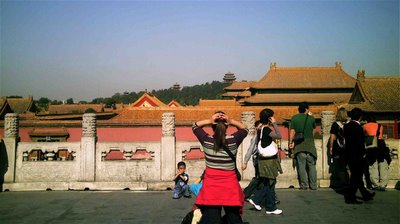
We didn't see all of it. One interesting piece was this one.

We then went by taxi to the Temple of Heaven.

The Temple of Heaven is actually a big park with about four temples, all connected with the emperor's role in offering sacrifices to the gods, and ensuring a good coming harvest. Lots of interesting stuff here, including a door that one emperor had installed since he was too frail to go through the regular way (being 70 years old). But lest his successors view this as an easy way out, he made a rule that the emperor could only use this door if he were at least 70 years old. I don't know what was stopping his successors from making a new rule. Maybe tradition.
We didn't see all of these temples. Even some of them that we visited were hard to see because of the crowd of people.

Then we went to the Silk Market (秀水), a multistory swap market selling everything from jewelry to cell phones to mahjongg sets to suits to yes, silk stuff. They even had someone carving clay sculptures of you while you wait. On the bulletin boards they have an English phrasebook for the sellers:

My final picture is from the sixth story of this, where you can see the Beijing skyline. No wonder Caterpillar is always running out of stock.
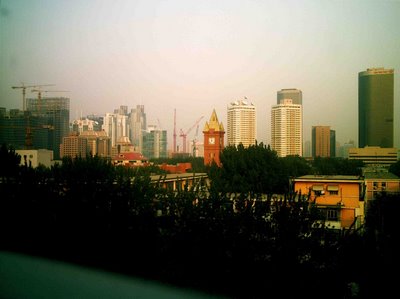
One addendum: It seems that uploading this stuff to Blogger is a LOT faster than it used to be. I used to dread putting up lots of pictures like this, knowing it would take hours. Now it zooms along. Not as fast as it would be ideally, but much, much, better than before. I know Blogger has been doing some upgrades. Looks like they were worth it.
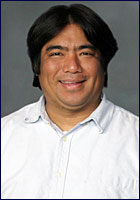

0 Comments:
Post a Comment
<< Home